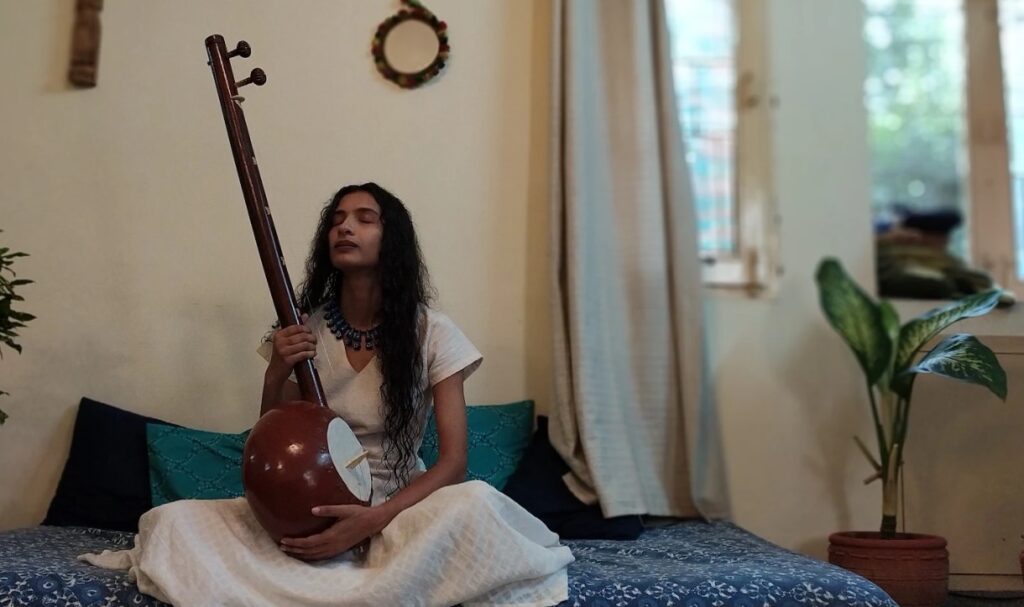
As a part of the July edition of Itisaras- ‘Art on the Edge: Performing Arts in Pandemic’, we had the opportunity to interview the founder of ‘The Aahvaan Project’, Vedi Sinha. ‘The Aahvaan Project’ is a folk music and story-telling collective that found its genesis in 2015. It is founded on the philosophy of love, empathy, and humanity and intends. It involves discovering and researching folk tradition extensively through travelling majorly in the Indian states of Madhya Pradesh, Uttar Pradesh, and Rajasthan- its villages, towns, and cities. The aspect of ‘The Aahvaan Project’ that one takes home with them is the simplicity yet the beauty, sheer compassion, and impact that each performance emanates.
During the last one and half years, the pandemic has disrupted all facets of our lives. Upon being asked how this has affected Vedi’s craft, music, and ability to connect with the audience given the fact that everything is happening through the virtual world, she had varied insights to offer. She relayed that even before the pandemic, artists were in a dire situation when it came to monetary support. There is a difficult balance that has to be gauged between presenting her work in goodwill and doing paid work.
Taking her art and artwork online was a mammoth hurdle that she had never considered as she associated her art form with the audience. It becomes difficult to steer through work when there is no monetary stability. Personally, she took the time to mentally and physically relax to evaluate what she had been doing versus where she wanted to go next; to reflect, consistently learn, and cruise more.
Vedi acknowledged the lack of regularity in freelancing. She says that a lot of organisations are working in a hand to mouth kind manner. However, there are big institutions that discount the fact that these artists are also people who need to pay bills which is unnerving. She ascertains that everybody considers “art to be co-curricular and not to be an integrated part of our lives”.

She recognises the privilege she has been born into with having the opportunities that she has been exposed to given her family’s economic and social standing. However, she is aware of the fact that this is not the case for many artists as they have been hit hard by the pandemic. She states how excruciating a process it has been during the pandemic to virtually work with folk artists from the practising communities of this folk music as they do not have the privilege of having internet and online classes. They lead a different lifestyle; they do not want to fundraise, they want work. Vedi is of the opinion that a “broader outlook to art and artists needs to be reworked”.
Upon being asked how she caters to the needs of her audience during the pandemic as we have shifted to the virtual space, Vedi touched upon various characteristics. She said how the sessions were planned in the same manner as a physical session would be there were no restrictions pertaining to numbers always. For her, as the medium of her work changed, her focus also changed. Before the pandemic, she did not have to worry about the production of her work. However, owing to not being tech-savvy, she has to do the production work on her own- record and upload, which takes its own sweet time.
Nonetheless, she reasserts how real communication happens through workshops and conversational sessions, be it musical or story-telling based setup. During the pandemic, some workshops work wonderfully because diversity is possible with people attending from various parts of the world. However, the number of attendees to such workshops is limited to her reach. However, Vedi feels the prime important part of the project, i.e., the workshops wherein one can talk and communicate to everyone is happening selectively due to the discord in people who have access to electricity and internet and who do not.
When asked about how the pandemic has affected the process of her art, Vedi remarked how creation was easier during the pre-COVID days without even intending to create- “when you are in and out of situations, there is more content to work with”. She concedes that right now there is an overwhelming amount of content from every walk of life which in itself is startling and triggers internal conflicts for her personally. The process of writing has become much more gruelling and it does not flow as it used to; because of which the themes are also getting affected. The songs now have the tension and anxiety weaved into the lyrics and music. She relays how the amount of art produced has reduced, however, the time taken to process the madness around is more. She states how it feels like there are sirens wailing, but nobody seems to be listening; “it’s a lonely space even to create art”.
Vedi was asked what would be the one thing that she misses the most and perhaps, hypothetically, would help her and her art to survive a little better right now. She answers by saying that before the first lockdown she had decided to embark on a journey with the goal of travelling to as many states, towns, and cities as possible with her ektara, songs, and conversations. All of that went south with the onset of the pandemic. She feels that now more than before such a journey would help her and she really looks forward to fulfilling this incomplete journey one day. She also wishes to physically meet all the people she has met virtually once things get better as that would be more experiential and enriching.
Lastly, when asked what her future plans and prospects would be in this “new normal”, Vedi ascertained that she cannot even begin to fathom sitting in a chair in front of a laptop for the long term. She hopes for things to get better, taking one step at a time as the alternative thought of uncertainties is anxiety driven; “as time changes you have to mould yourself accordingly”.
To know more about how the pandemic has impacted the performing arts sector, especially folk artists please watch our full interview with Vedi Sinha below:
We, at Itisaras, believe that awareness and action are integral for change, and for the same we have launched a petition on change.org that urges the Ministry of Culture to extend institutional support to the people of the Performance Arts sector. Please join us and sign the petition – http://chng.it/zhFTnGdPMm



I am often to blogging and i really appreciate your content. The article has really peaks my interest. I am going to bookmark your site and keep checking for new information.
I like this web blog so much, saved to my bookmarks. “I don’t care what is written about me so long as it isn’t true.” by Dorothy Parker.
There is noticeably a bundle to know about this. I assume you made certain nice points in features also.
Really enjoyed this blog post, is there any way I can get an alert email whenever you publish a fresh post?
I like this web site because so much utile stuff on here : D.
It’s really a cool and useful piece of information. I’m happy that you just shared this helpful info with us. Please keep us informed like this. Thank you for sharing.
Hello, i think that i saw you visited my weblog so i came to “return the favor”.I’m attempting to find things to improve my web site!I suppose its ok to use a few of your ideas!!
Normally I do not read article on blogs, but I would like to say that this write-up very forced me to try and do so! Your writing style has been surprised me. Thanks, quite nice post.